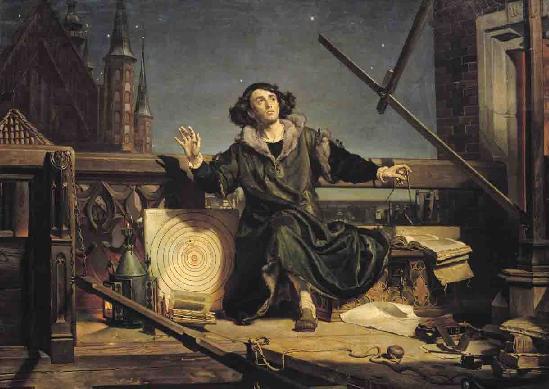Heliocentrism and geocentrism. How to reconcile divergent viewpoints that were never intended to be reconcile, for they represented thoroughly different values. Even Martin Luther was wary of the Copernican revolution, the end result being idol worship, the view that it would be easier to persuade man that nothing stands higher than himself, that men would do “good deeds” for all the wrong reasons, that is man approves of it, because it makes sense to him, and that man alnoe ultimately decides the validity of any idea, any code, and discipline, and would become the sole arbiter of right and wrong in Copernicus’s evolving age of humanism, where human activity is to meet the approval of man, and, as Luther feared, not because of Divine commandment…

—The front piece of G.B. Riccioli’s Almagestum Novum, 1651. Notice that he does not use Tycho Brahe’s system but his own variation of it where Jupiter and Saturn are centered on the Earth. —Read More:http://www.math.nus.edu.sg/aslaksen/teaching/copernicus.html
…Next, by assuming that the earth was not the center of the universe, but itself a moving planet, and by making all the planets revolve around the sun, the motions of the planets became simpler. For example, Mars and Jupiter have the awkward habit of appearing at some points in their orbits to move backward, contrary to their bormal motion. This “retrograde motion” Copernicus explained as being the result of the earth’s motion. The terrestrial year is shorter than the Martian or Jovian year, and so the earth sometimes appears to overtake the so-called outer planets, those that are located beyond the sun, making it appear that these planets are moving backward.

—Jan Matejko’s portrait of the astronomer in Toruń. However, Krakow authorities decided to keep the portrait in Krakow to mark their own anniversary celebration. Today the work is hanging in Jagiellonian University Museum in Krakow.—click image for source…
Two points must be noted here. The first is that Copernicus differed from his predecessors in his postulation of the motion of the earth by the fact that he genuinely believed it represented physical reality. Indeed, his very belief that a knowledge of physical reality was attainable is in itself in marked contrast to the beliefs of Scholastic thinkers, who held that only Revelation, which came direct from God, gave certainty and that man could by reason attain only to possible, probable, or contingent truths.
Copernicus was aware that the observations available to him, whether his own or those of others, were necessarily insufficient and probably not as accurate as they might be, and this might mean the necessity of correcting his tables and figures, but he never doubted that the aim of astronomy was to achieve a description of physical reality, of nature as it really was. Andreas Osiander’s preface to Copernicus’s thesis was therefore the absolute denial of one of Copernicus’s greatest contributions to astronomy- the conviction, which his successors readily adopted, that it was the business of the astronomer to describe the motions of the planets as they really are…. ( to be continued)…
ADDENDUM:
(see link at end)… Even if Luther had called Copernicus, who was not mentioned by name, a fool, that would have been a rather mild epithet coming from Luther. The “Table Talk” was based on notes taken by students of Luther. The notes were compiled and first published in 1566, twenty years after Luther’s death . Thus the remark cannot be construed as part of a concerted attack on Copernicus or Copernicans. The use of the word “astrologer” in the introductory remarks should not necessarily be interpreted as disparaging, since at that time the terms “astrologer” and “astronomer” were often used more or less synonymously….
Luther saw that Copernicus’s view was indeed a revolutionary one. He could not accept it because it was contrary to his common sense and his interpretation of the Bible. That a person in a cart moving at constant velocity is at rest with respect to the cart, while trees are in motion with respect to him, is an example of what is now called Galilean relativity. By quoting Joshua Luther, of course, did not refute Copernicus . Johannes Kepler later applied Luther’s own principle of biblical interpretation to the passage by saying that it only appeared that the sun stood still, but it would actually have been the earth . …
… Whether Osiander’s note was a positive or negative influence on the acceptance of Copernicus’s book has been greatly debated. By emphasizing the commonly held view that astronomical hypotheses should not be taken as truth, Osiander’s note probably made the reception of On the Revolutions more favorable . Osiander’s view was accepted at the University of Wittenberg. Not until 1616 when Galileo’s discoveries with the telescope gave empirical evidence in support of the heliocentric view, did the Catholic Church move to suppress the Copernican view.
The other professor of mathematics at the University of Wittenberg, Erasmus Reinhold, became familiar with the Copernican view between 1541 and 1542 through Rheticus . He was neutral on the question of geocentrism or heliocentrism, but he appreciated the simplicity of the Copernican view because it eliminated equants. Reinhold systematized and recalculated the motions which Copernicus had discussed in On the Revolutions . He produced the Prutenic Tables, which were named in honor of Albrecht, Duke of Prussia. On the basis of positive letters from Melanchthon, Albrecht had given financial support to Reinhold . The practical success of Copernicus’s viewpoint in Reinhold’s calculations paved the way for a more complete acceptance of heliocentrism when additional evidence became available . Read More:="http://www.leaderu.com/science/kobe.html">http://www.leaderu.com/science/kobe.html





 COMMENTS
COMMENTS